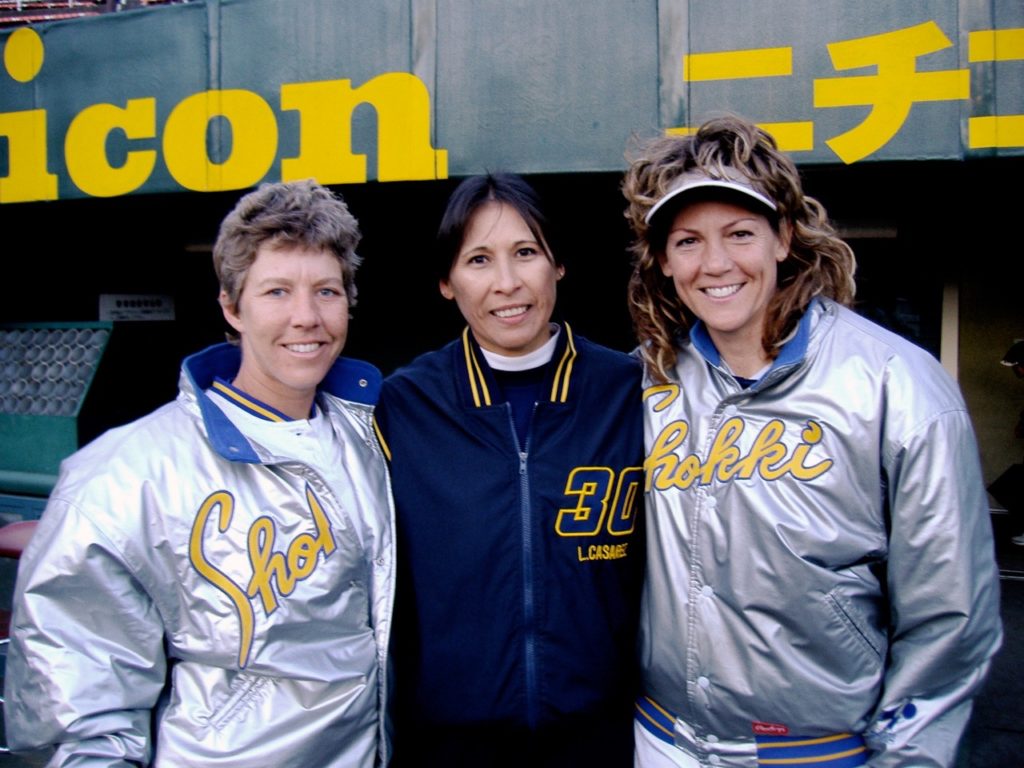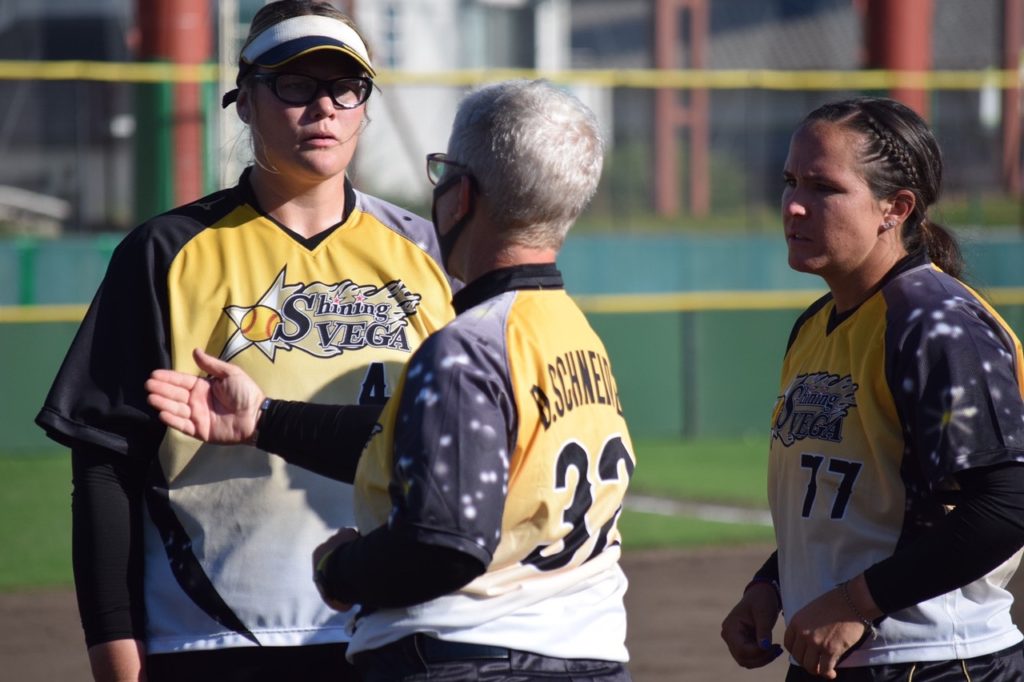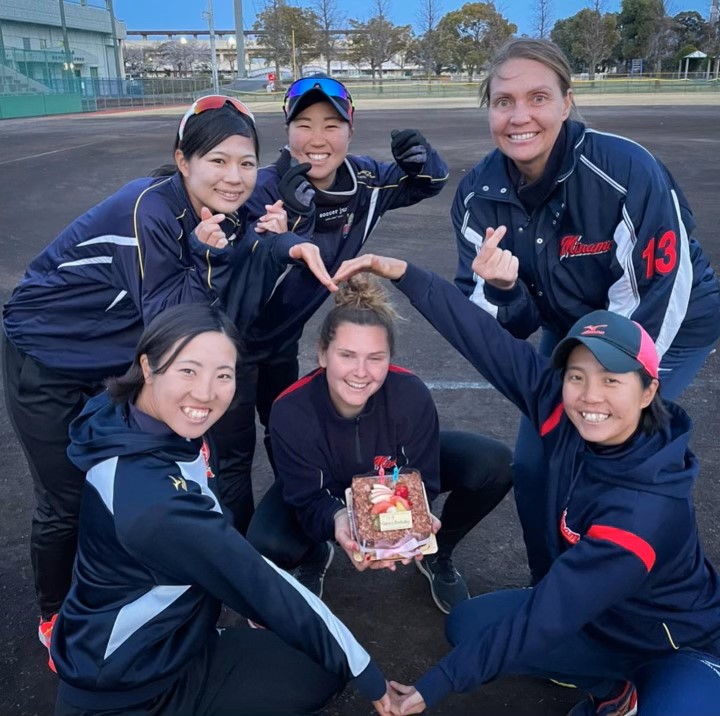Note: this article was written in conjunction with our friends at Baseball Jobs Overseas. It will also be posted on their blog.
Right off the bat, Chelsea Goodacre realized that playing softball in Japan was going to be different.
“The first practices were real eye-openers,” said the former all-American from the University of Arizona, who is a catcher with Toyota Shokki in the first division of the Japanese Women’s Softball League. “We practiced six hours a day. At first, I tried to do everything they did, but that only lasted a day and a half.”
Yet, she and other import players in Japan have lasted – and succeeded – despite significant differences in language, culture, food, style of play, approaches to the game, and much more.
So, the question is, “how?”
Succeeding outside one’s home country involves more than ability and knowledge – to survive and thrive, one must adapt. The rules of the game may be the same, but the way the game is played often is not.
And, for westerners playing in Asia, there is hardly anything familiar about life off the field.
The experience can be meaningful and rewarding, but it can also be disappointing. While it’s important to produce on the field, how a person deals with it all – the different, the funny, the confusing – is a major factor determining success or failure.
“I try to open up to the culture as much as possible and take in all I can,” said Dallas Escobedo, an American from Arizona who pitches for Toyota Shokki. “I try to show respect for everything.
“There are players that come here and stay just a season. There is definitely some adjusting to do, and not everyone can work through it. You end up being alone a lot when you’re not playing or practicing, and not everyone is okay with that. If you’re not able to fill your off time, it can be a struggle.”
The players that successfully work through the challenges are the ones who embrace the differences, show a willingness to learn new things, and go with the flow.
Those players end up liking the country and having incredible experiences.
Ellen Roberts, an Australian who played college ball in the United States and now pitches for Minamo Ogaki in the Japanese first division, recalled, “While at first I noticed a big difference in culture, I immersed myself in every way possible – learning the language, trying new foods, and embracing the Japanese way. I loved the new aspects and challenges of life in Japan, and it was just the start of what life in Japan was going to be like.
“Other than the language, the biggest challenges were the workload and the schedule itself,” she added.
“As part of my contract, I actually work for the company – an international transportation company – that sponsors the team. I work in the mornings, and then we practice from 1pm to 7pm, with optional practice after that. It’s grueling, but worth it – I’ve learned a lot, and I love the opportunity to work.
“It’s helped me understand the culture better and pick up more of the language. You have to be open-minded.”
And from Goodacre – “When I came over, I didn’t say anything and just did what they did. It’s a bit different this season because I have some experience, but I just try to give input that might be useful. The biggest thing is understanding that it’s their game. I’ve known of some players who couldn’t adjust and went home after one season. It can be a shock if you’re not able to adapt and take things in stride.”
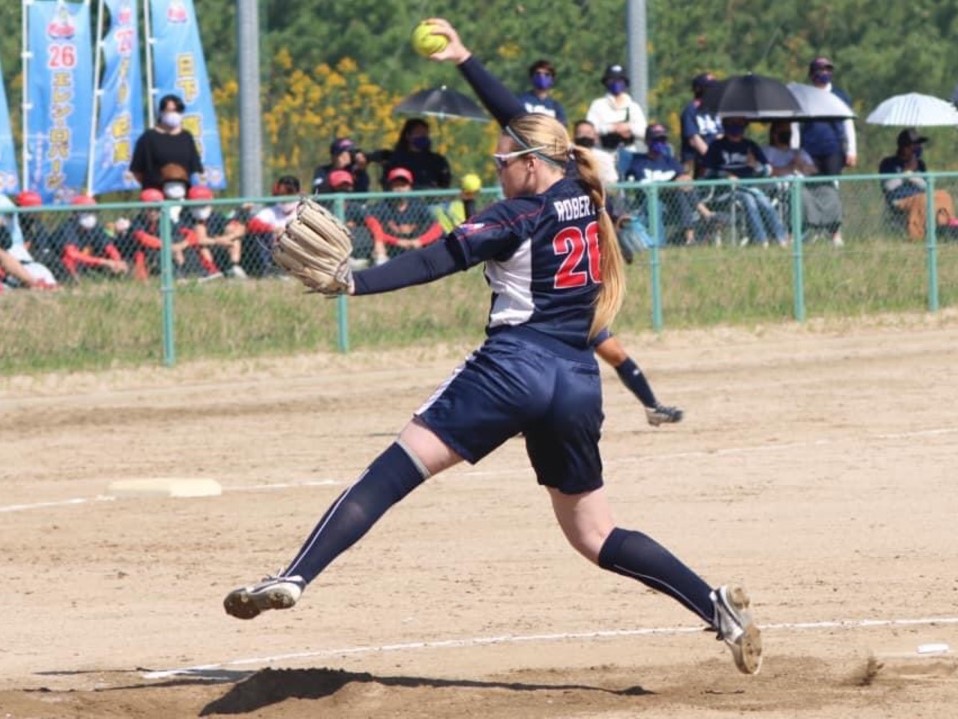
The initial shock was literal for Sarah Pauly, a pitcher for Minamo Ogaki, who first came to Japan in 2011, just a week or so after the earthquake and resulting tsunami that severely damaged the nuclear power plant at Fukushima.
“Some other foreign players were coming in that day and had to be re-routed,” Pauly said. “We felt the aftershocks for several days and months afterward.”
For Pauly, that first experience was “kind of a blur. It was my first time overseas, and I didn’t take in the culture. It was extremely difficult being away from home, and I didn’t care for the adventure or travel. I was there to play softball and didn’t do much other than that. I came over here, rushed right into playing, and quit right after the season, even though the team asked me to come back.
“I was pretty immature when I first went there, and I remember telling my parents later that not taking full advantage of that opportunity was the biggest mistake I’d made,” Pauly continued.
“I said that if I had another chance to go there, I’d do it in a heartbeat.”
She got that chance in 2014.
“I really saw the country the second time,” she said. “I was mesmerized by the food, the culture, and different places. It was like I’d never been there before, even though I had, so the experience was much different than the first time I played in Japan.”
Cultural differences abound, from the obvious to the seemingly insignificant. But, no matter how small, the differences add up and make for a period of adjustment.
Chopsticks, for one – not just how to eat with them, but also what to do with them when you’re not eating.
Pauly learned that it’s considered bad etiquette to leave them anywhere but on top of one’s bowl when finished – “Once, after I first came to Japan, I stuck my chopsticks in the leftover rice, and someone actually came over and put them on the bowl.”
The food challenges don’t end with the utensils.
“Our players have to eat all their food, even if they’re full,” she said. “If not, the implication is that they don’t like it.”
The players have to weigh their rice to make sure they only eat a certain amount. Some fans bring snacks to the players at practices and games; the older players get to eat first, and it goes down the line according to age. With many teams, seating on the bus is regimented, as well – the captain and older players in the back and the younger players sitting forward.
Escobedo said she has to have three pairs of shoes wherever the team goes – a clean pair for the gym, a clean pair of cleats, and a pair to wear outside – “You can’t wear your gym shoes outside. There is so much attention to detail as far as keeping everything neat and clean. Luckily, I’m that way myself.”
Language is constantly a challenge, and sometimes a source of humor. “Throwing a runner out,” for example, translates to “make the runner dead.” Escobedo once referred to a crate of balls as a “box,” and none of her Japanese teammates understood what she meant. Also, Japanese tend to add an extra “o” to many English words – “Friend-o,” “Cost-o-co,” “McDonald-o” – and often don’t understand what one is saying without it.
For the players, perhaps the biggest areas of adjustment come with the practices and the style of play.
The amount of time Japanese teams practice is famous . . . or infamous, depending on who is talking.
“Practices are crazy,” said Lisa Maulden, an American first baseman and designated hitter for Minamo Ogaki. “We had to take 15,000 swings in 23 days, and I thought I couldn’t do it, but I did. Pitchers had to run about 30 times a day from foul pole to foul pole.
“It’s good to an extent, though,” she added. “Some coaches will have you practice hitting foul balls. [My coaches] said foul balls were okay – that I needed to be swinging – and it changed my approach at the plate. Before, I was seeing more pitches and waiting for a good one to hit.”
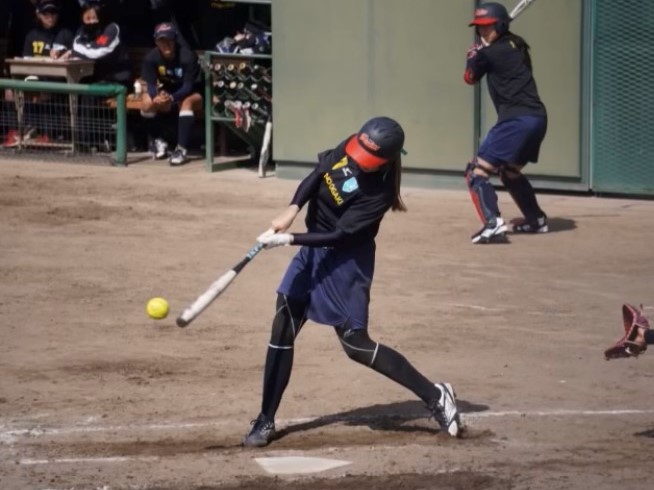
Still, the practice process, for the lack of a better term, is an area where the go-along-to-get-along philosophy undergoes some modifications. To an extent, they can do things their way as long as they produce on the field, though all try to fit in as much as possible.
“The imports have some leeway to modify things,” said Escobedo, an alum of Arizona State University who also pitches for Mexico’s Olympic team. “They let us kind of pick and choose what we do.”
Roberts added, “They’ve always let me do the training program I want, but I want to be part of the team, so I try to do what they do as much as possible. Once in training camp, we had a four-hour fitness test, and I did it all. From the Australian point of view, we tend to focus on quality over quantity. In Japan, it’s quality and quantity.”
Perhaps none of the imports have Debbie Schneider’s perspective. Schneider – the battery coach for Tokyo Shokki – is in her 30th season with the club. She was a catcher for 14 seasons and has been a coach since.
“I had a job I was reluctant to leave, but I decided to give Japan a go for a year, maybe two. After all, the money was better than what I was making, and I didn’t have to wear heels and a skirt – just play around in the dirt like when I was ten years old,” Schneider said with a laugh.
Since then, she’s seen things change . . . and not change.
“The practices – oh, wow,” she said. “They have changed some . . . They’re a little shorter now, but I still have a hard time getting used to them. Our people work for the company from 8am to noon and then practice from 1:30 to about 6.
“But when I first came here, we all had to work from 8am to 3:30pm, and then we’d practice until 9:30 or 10. On weekends, practices would be from 8:30 to five or six. I’d be exhausted. I never went anywhere on our day off because I just wanted to rest.”
Although shorter than they used to be, the practices are still tough.
“They do this thing they call “Brazil Taiso” – like the military with a lot of chanting – and they do it for 45 minutes,” Schneider said. “It’s amazing that they can do that and still practice. That’s one thing I find very bizarre. And the amount of batting they do – long tee, short tee, machine, live pitching. Then they’re back inside doing it again after practice – every day. I sometimes think they need to give themselves a break.”
Roberts added, “I’m sometimes in awe of what they do. They hit several hundred balls a day in practice. Back home, we might take a week to do that. Also, they’ll hit off the tee, do a squat, hit off the tee, do a squat . . . and just keep doing that.”
Most import players are permitted to prepare in a way that works for them. The successful ones find a way to blend their routines with that of their Japanese teammates.
Pauly explains: “The best piece of advice I got was to do what I needed to do to prepare myself. I do everything with the team, but I have my own workout plan. Here, pitchers throw in the morning, and then they throw in the afternoon after lunch. If I did that, I would hurt myself. Instead, if I only need to throw a 30- or 45-minute bullpen session, that’s what I do. If you know your plan will set you up for success, you need to stick to it. I always try to stay and help however I can, though, and the teams I’ve played on have all been okay with what I was doing.”
Escobedo has a similarly toned town plan: “Since I’m a pitcher, I’ll do a 45-minute bullpen, then work on defense, then go into the weight room for my training. Our other pitchers do throw a lot – hour-long bullpens of 70-90 pitches and then throw batting practice that will amount to 200-250 pitches. I try to keep my pitch count to between 80 and 120.”
But it’s not just pitchers that feel the need to limit their reps. Goodacre explains, “I’ll take 200 swings a day, and the others do twice as much or more. And they do even more on their own after practice. They’re very quantity-focused.”
The long hours of practice and preparation apply to games, too. Escobedo’s team begins their warmups about three hours before game time. They’ll hit for up to 45 minutes, then do drills like playing pepper, then warm up some more before changing into their uniforms and having a break to snack on rice balls.
As to the style of play, it’s similar to Japanese baseball in that there is more small-ball, less emphasis on power, and a greater reliance on off-speed pitches. According to the import players, the gameplay in Japan is more structured and less based on feel, flow, and instincts than in other countries, which can sometimes be frustrating or perplexing.
- Schneider: “We’re more about power, while they’re more about the small game. They’re very good at that. When they aren’t hitting well, they rely more on things like bunts and the hit-and-run. The players today are extremely good – amazing, but their ability to adjust to situations that come up is less than when I first came here. If a play comes up that they haven’t practiced, they can be at a loss.”
- Goodacre: “Watching the Japanese play defense is like watching art. All the games here are intense, and the level of talent is very high. Given all the practice, they’re often better at various skills. But they don’t go with the flow of a game as easily – what you do when something goes wrong. They want an answer – a plan – for every single thing.”
- Maulden: “They definitely pitch foreigners differently. Occasionally, they’ll challenge you inside with something hard, but most pitches are off-speed. I think probably six or seven of my first ten hits here were off change-ups.
- Roberts: “They’re very nimble, and they practice so much that they don’t make a lot of errors. That’s part of the reason they’re so successful. You have to be ready for anything. Their swings are short, explosive, and very compact.
- Schneider: “When I came here, the strike zone was quite wide, especially outside. It’s a little better now, but we sometimes have to reach and foul off wide pitches. Foreign pitchers have smaller strike zones than Japanese pitchers, too. I think it’s because foreigners tend to have more movement on their pitches. We struggled with that when Michelle Smith first came over. She was a rise-ball pitcher, and they weren’t calling strikes. I kept telling the umpires that what counts is where the ball crosses the plate, not where the catcher receives it. Little by little, they got it, but we had a terrible time at first.”
- Pauly: “They use multiple cutoffs instead of letting the outfielders use their arms. Outfielders will throw to one cutoff person, who throws to another who then throws to try and get the runner. I’m not sure why they can’t do that with just one cutoff.”
- Maulden: “They’ve adapted the game to their body types. Their mechanics are different in some ways. As I see it, they’ve revamped the game and made it a Japanese-style sport. Their men’s and women’s teams are both ranked #1 in the world, so it clearly works for them.”
The Japanese players have had to adjust to their foreign teammates, as well.
“I believe the Japanese sometimes have a different view of Americans since we do practice less and train much less than they do,” Goodacre said. “However, I think they’ve come to realize that the players who come over here and immerse themselves have the same great passion for their teams and the game.”
Schneider further explains why it can be difficult for an import player to fit in: “They pay you a good salary, so you’re automatically expected to perform,” she said. “But we’re just as human as they are and will have good days and bad days, and it’s not as easily forgivable with us as it is for the Japanese players. That adds pressure. Having a friend or mentor here really makes a difference. I had a friend on the team when I first got here, and she really helped, so I do that for others. I’ve seen foreigners who didn’t have that support, and it was more difficult for them.”
Despite that, Schneider has no plans to leave the Japanese game.
“I love what I do,” she said. “I’ve always been on one-year contracts and thought for sure there would come a day they’d say, ‘We don’t need you anymore,’ but I’ll keep doing this as long as they ask me to come back.”
